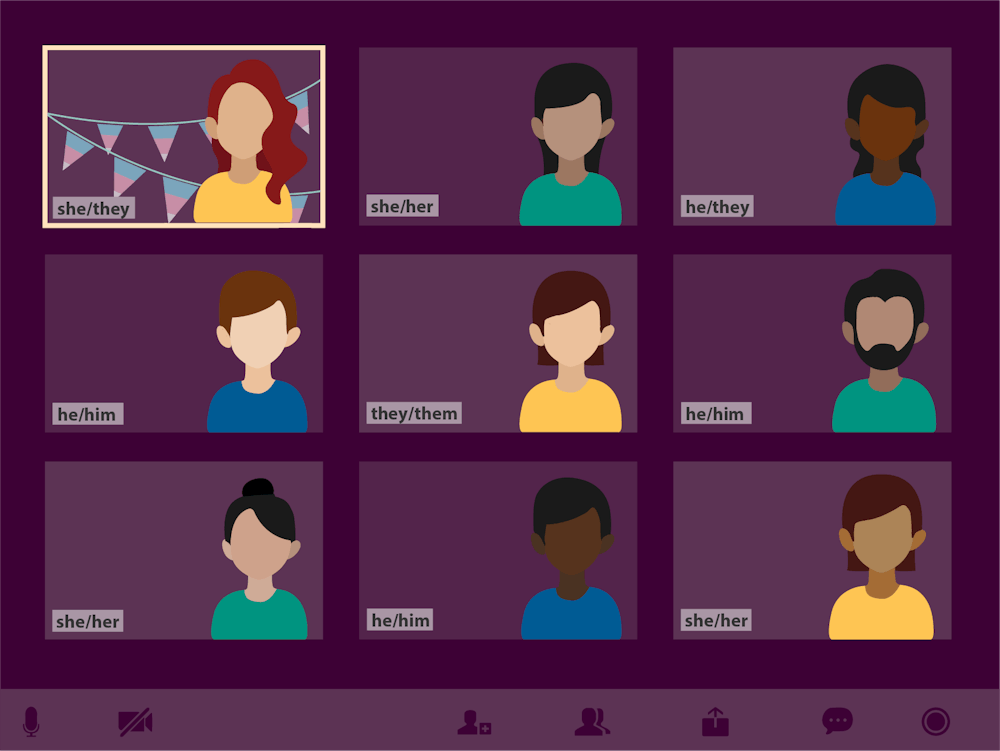The topic of gender identity and nonconformity has recently sparked numerous debates in the United States relating to rights of identity, using the bathroom and even athletic involvement.
Transgender people often include their pronouns in their social media profiles and email signatures to express their gender virtually. With the transition to online instruction, trans students have begun to include their pronouns in their display names on Zoom and Canvas.
Some trans students, like senior Syd Overtoom, have begun to feel outed and alienated by this practice as most professors and cisgender students do not do the same. Overtoom said even professors that asked all students for their pronouns have been misgendering them.
“One of my professors praised me for being the only student that has pronouns in their bio when no one else did,” Overtoom said. “But I’ve been misgendered twice in that class.”
Overtoom and second year student Gwen Smith, who uses she/him pronouns, have faced similar challenges as nonbinary students.
“Even when other people have their pronouns, I’m the only one with the odd looking ones,” Smith said
Fewer than half of the two students’ professors have asked for their students’ pronouns or requested students display them during class. According to Smith and Overtoom, the professors that do require proper pronoun use in class have not strictly enforced any rules.
“People will do it only when the teacher asks them," Overtoom said. "It’s not the default. It really is a sign of privilege for cis people.”
Transitioning to virtual classes has given trans students mixed emotions on their ability to pass.
“The nice thing about Zoom class is that you can just put your pronouns for everyone to see,” Smith said. “I think it really helps but it really hurts to only have your face and your voice to prove it.”
Smith also feels that being in person would create more anxiety of being questioned or harassed. However using her pronouns has led to uncomfortable conversations on her identity with professors.
“I shy away from using the pronouns during smaller meetings and office hours because I don’t want to invite any more uncomfortable talks with people who don’t understand or are hostile towards it,” Smith said. “I can explain it. I just only want to explain it to someone who’s going to receive it. I just want to use my pronouns. I didn’t want to become a philosopher.”
For Overtoom, these conversations are necessary to encourage instructors to motivate students to include their pronouns and employ trans-inclusive language during class which have shifted from being sparked by their instructor to themself.
Juno Martin, a third year student in Illustration, has felt neutral towards her presentation online.
“It’s been about the same worry,” Martin said. “I notice myself on the camera trying to look pretty. I worry about it, but I’m not doing enough to try to pass.”
A common problem that has contributed to the misgendering of Overtoom and the discomfort of Martin is related to their voices.
“There’s plenty of times where I have something to contribute to a class discussion, but then I’m like I don’t want to speak right now,” Martin said. “I’m not super dysphoric about my voice by default — it’s only because of other cisgender people that it became a problem.”
Martin, Overtoom and Smith recommend students normalize including their pronouns in their name tags during class and on social media profiles. They also recommend using online resources, attending the bimonthly ally training provided by IU’s LGBTQ+ Culture Center or asking trans people about their perspectives.
“Become more aware, ask questions without being intrusive,” Martin said. “The best way to know more about our experience is to ask.”






